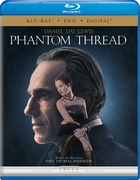BLU-RAY REVIEW

Phantom Thread
Featured In Issue 226, April 2018
"Phantom Thread" is set in the glamour of 1950's post-war London. Renowned dressmaker Reynolds Woodcock (Day-Lewis) and his sister Cyril (Manville) are at the center of British fashion, dressing royalty, movie stars, heiresses, socialites, debutants and dames with the distinct style of The House of Woodcock. Women come and go through Woodcock's life, providing the confirmed bachelor with inspiration and comfort, until he comes across a young, strong-willed woman, Alma (Krieps), who soon becomes a fixture in his life a his muse and lover. (Gary Reber)
Special features include camera tests with commentary by Director/Writer Paul Thomas Anderson (HD 08:42), the "For The Hungry Boy" collection of deleted scenes (HD 04:51), the "House of Woodcock Fashion Show" narrated by Adam Buxton (HD 02:47), behind-the-scenes photographs, upfront previews, and a Movies Anywhere digital copy.
The 1.85:1 1080p AVC picture, reviewed on a Sony Bravia Z9D 4K Ultra HD HDR display, upconverted to 2160p with greater resolution and luminance, was photographed on Kodak Vision3 film stock with the Panavision Panaflex Millennium XL camera system and sourced from a 2K master Digital Intermediate format. The picture exhibits a light film grain throughout, which contributes the overall softness of the imagery when not in close-up. In close-ups, resolution is finely detailed, revealing facial features, skin pores, hair, clothing fabrics, and object texture. Color fidelity is nicely saturated, with strong primaries such as reds strikingly standing out. Colors exhibit an engaging warm and rich naturalness. Fleshtones are naturally rendered throughout. Contrast is excellent, accentuated with both natural and artificial lighting, putting an emphasis on the period production design. Black levels are deep yet revealing in fine detail, as is shadow delineation, and bright highlights nicely contrast with the darker elements in scenes. This is a beautifully filmed picture that salutes the work of dress and attire design amongst the elite of England. The clothing design was recognized with an Academy Award® for Costume Design. (Gary Reber)
The DTS:X/DTS-HD Master Audio™ 7.1-channel soundtrack is dialogue focused with a pace that is slow and uneventful. The music accompaniment is at times orchestral but mostly piano. A pillow at hand will nicely serve to rest on, as this is a very slow and sleepy soundtrack, with virtually no excitement. Fidelity is a bit subdued and muffled, especially the piano, which was recorded in a large reverberant space. The orchestra is nicely dimensional across the soundstage. Atmospherics are real enough and occupy the soundstage with some sense of dimensionality. Foley sound effects are predominant and well crafted. Surround envelopment extends to all four surround channels, but at extremely low levels and thus, not perceived as an effective soundfield. There are two or three scenes in which the basses of the orchestra extend deep and energize the .1 LFE channel, but otherwise deep bass is not an often-used sound element. Dialogue is dominant throughout and consistently intelligible with good spatial integration. As for the Immersive Sound element, it really does not have any impact nor does it enhance the sonic dimensionality as it is also frontal focused. Essentially, it is absent any effective music with just the brief here and there extension of the orchestra and piano, but does occasionally contain dialogue, ambient sounds such as street noise and cars, a ballroom crowd ambience, car motor noises, nuanced birds chirping, wind by the sea shore, restaurant ambience, light footsteps, soft chatter, a festival celebration of cheering people and other nuanced ambient sounds. None of this really contributes to the sense of immersion. Overall, this is a generally quiet soundtrack that sounds realistic but with little in the way of energized surround or height envelopment. (Gary Reber)

 then "Add to Home Screen"
then "Add to Home Screen"